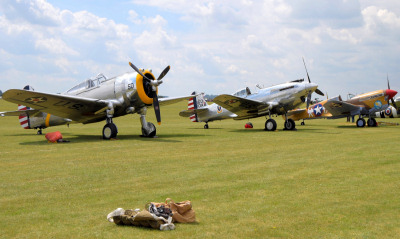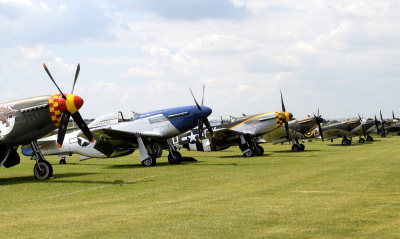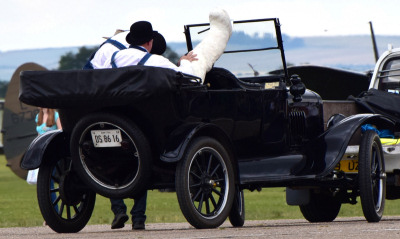
The
'Flying Legends' air show is organised and produced by 'The Fighter Collection', based at Duxford in Cambridgeshire. This event took place on Saturday 8th and Sunday 9th July 2017 and combined the flying displays of historic warbirds, along with engaging nostalgic activities, to create an authentic 1940s atmosphere at IWM Duxford's wartime airfield.
As usual, this ticket-only event, which also requires a £5 vehicle parking permit for those travelling by car, includes free access to the superb museum, which is well worth exploring before the air display. There is also plenty of entertainment on the ground including the 'Vintage Village' which opened at 9am, until the air display started, and then reopened from 5.30pm to 6.30pm, after the flying display. The 'Vintage Village' included 'The Manhattan Dolls', 'The Umbrella Big Band', 'Laurel & Hardy with model T-Ford', Large scale model warbirds, 1940's hair & makeup demonstrations and the opportunity to have your photograph taken while you sit in a replica Spitfire Mk.IX.
At a cost of £5 per person, you were also able to get much closer to the aircraft on the ground with the 'Flight Line Walk', which was open from 9am until 12pm.
This year, Duxford is commemorating the centenary of the Imperial War Museum (IWM) and 100 years since work began to create RAF Duxford in 1917. To help celebrate the centenary, an innovative large-scale sculpture 'DX17' has been created by the BAFTA award-winning composer and multi-disciplinary artist Nick Ryan, which will remain open to the public until September.
The
layout of the crowdline, following new safety measures, was the same as last year, where the crowdline was moved forward in the central area of the museum site, and the Land Warfare end of the site was closed off during the air show weekend.
The flying display started at 2pm until 5.30pm on both days, although unusual for 'Flying Legends' it included a display from the
Red Arrows on Sunday only. This however was a separate pre-show act which took place at 1.20pm on Sunday before the actual flying display began. The Red Arrows performed along an alternative display line so that they could avoid flying over Duxford village, which is similar to what happened at the
RAF Cosford Air Show last month. This meant that those spectators to the West of the airfield (Land Warfare Hall end) were able to view the Red Arrows better than those positioned at the Eastern M11 end.
At the start of the flying display we saw nine Spitfires take off and perform tailchases and flypasts.
In the summer of 1938, Duxford saw the first example of the Supermarine Spitfire (serial K9792). This aircraft was entrusted to 19 Squadron, which went down in history as the first operational Spitfire Squadron. During the Battle of Britain in 1940, Duxford saw a lot of activity even though it was some way to the north of the main scene of action. Its aircraft were frequently scrambled against the Luftwaffe.
Twelve Spitfires, including one Seafire, took part in the flying display. These included
Spitfire MkI (X4650/G-CGUK),
Spitfire MkIa (AR213/G-AIST) both owned by Comanche Fighters in Texas and based at Duxford with 'The Fighter Collection',
Spitfire MkIa (N3200/G-CFGJ) owned by the IWM, Duxford,
Spitfire Vb (BM597/G-MKVB) of Historic Aircraft Collection Ltd,
Spitfire LFVb (EP120/G-LFVB) of The Fighter Collection,
Spitfire Mk IXb (MH434/G-ASJV) of the Old Flying Machine Company,
Spitfire HF Mk.IX (RR232/G-BRSF) of Boultbee Flight Academy,
Spitfire FR XIV (MV293/G-SPIT) of Anglia Aircraft Restorations Ltd,
Spitfire Mk XVIII (SM845/G-BUOS) of Spitfire Ltd. There were also two Spitfire trainers:-
Spitfire Tr.9 (ML407/G-LFIX) of Air Leasing Ltd (Grace Spitfire) and
Spitfire Tr.9 (IAC-161/G-CCCA) of the Aircraft Restoration Company. The Seafire was
Seafire LF III (PP972/G-BUAR) of Air Leasing Ltd. More information on these Spitfires can be found on the
Airworthy Spitfires page.
Naval Fighters were represented by a
Goodyear Corsair FG-1D (G-FGID),
Grumman Bearcat F8F (G-RUMM) both from The Fighter Collection, and
Hawker Sea Fury Mk.II (G-CBEL) of Anglia Aircraft Restorations Ltd.
The Corsair was an American naval carrier-based fighter-bomber which saw service in WW2 and the Korean War. The powerful F8F Bearcat was also an American carrier-based fighter aircraft which entered service too late to see any action in WW2 but saw combat service in the Vietnam War. The Hawker Sea Fury was a British fighter aircraft and was the last propeller-driven fighter to serve with the Royal Navy. It was one of the fastest production single piston-engined aircraft ever built. The Sea Fury saw action in the Korean War and was used primarily as a ground-attack aircraft, operating from Royal Navy light fleet carriers.
Curtiss Fighters included the
Curtiss-Wright Hawk 75 (G-CCVH),
Curtiss-Wright P.40C (G-CIIO) and
Curtiss-Wright Warhawk P40F (G-CGZP) aircraft which are all part of The Fighter Collection, based at Duxford.
The Curtiss-Wright Hawk 75 (or P-36 Hawk) was an American-designed and built fighter aircraft of the 1930s and 40s. It was one of the first of a new generation of combat aircraft with a sleek monoplane design making extensive use of metal in its construction and powered by a powerful radial engine. The P-40 was an American single-engined, single-seat, all-metal fighter and ground-attack aircraft that first flew in 1938. Its design was a modification of the previous Curtiss P-36 which reduced development time and enabled a rapid entry into production and operational service. It was used by most Allied powers during World War II, and remained in frontline service until the end of the war.
The
B-17G Flying Fortress 'Sally B' (G-BEDF) was next to display and was joined by P-51 Mustang escorts. The B-17 Flying Fortress was a four-engine heavy bomber developed in the 1930s for the United States Army Air Corps. It was used in the daylight strategic bombing campaign of World War II against German industrial and military targets. B-17 Losses were severe but with the introduction of the P-51 Mustang they had a long-range fighter that could escort the bombers to their target and back. The B-17 bomber crew labelled the P-51 Mustang escorts as 'Little friends'.
Next up were the 'Classic Formation' of two Beechcraft Model 18's and one Douglas DC-3. These were
Beech 18 (N21FS),
Beech 18 (N223CM) and
DC-3 (N431HM) which are operated by Hugo Mathys. The Beech 18 is a 6 to 11 seat, twin-engined, low-wing light aircraft manufactured by the Beech Aircraft Corporation of Wichita in Kansas. They were produced from 1937 to 1969 and served in World War II as light transport, as an aircrew trainer and for photo-reconnaisance. In civilian use it was operated as a civilian executive, utility, cargo aircraft, or passenger airline. The DC-3 revolutionized air transport in the 1930s and 1940s and was also used in World War II by the armed forces of many countries for the transport of troops, cargo, and the wounded.
Displaying next was 'Luftwaffe/North Africa campaign aircraft' which consisted of a
Bucker Jungmann (G-BSAJ) operated by Skytricks,
Bf109 Buchon (G-AWHK) operated by the Aircraft Restoration Company and
P40F Warhawk (G-CGZP) operated by The Fighter Collection. The Bucker Jungmann was a 1930s basic trainer aircraft which was used by the Luftwaffe during World War II and the Bf109 Buchon (Hispano Aviacion HA-1112) was a license-built version of the Messerschmitt Bf 109G developed in Spain during and after World War II.
This particular Bf109 Buchon has appeared in the film 'Valkyrie' starring Tom Cruise and presently wears a heavily weathered desert paint scheme to represent Messerschmitt Bf109 E-7 "Black 8" of JG27, flown by Leutnant Werner Schroer.
The excellent 'Battle of Britain' display was next and included the
Bristol Blenheim Mk.I (G-BPIV) operated by the Aircraft Restoration Company,
Hawker Hurricanes,
Supermarine Spitfires and the
Bf109 Buchon (Hispano Aviacion HA-1112).
The Bristol Blenheim was a British light bomber aircraft, introduced in 1937, that was used extensively in the first two years of the Second World War. The Blenheim was one of the first British aircraft to feature an all-metal stressed-skin construction, retractable landing gear, flaps, a powered gun turret and variable-pitch propellers. It was used as an interim long-range fighter and as a night fighter.
This year's display featured no fewer than five Hurricanes. These included
Hurricane Mk.I 'P3717' (G-HITT) and
Hurricane Mk.I R4118 (G-HUPW) which are both based at Old Warden Aerodrome and operated by Bygone Aviation Ltd. There was also
Hurricane Mk.I P2902 (G-ROBT) operated by Anglia Aircraft Restorations Ltd and
Hurricane XII 'Z5140' (G-HURI) operated by Historic Aircraft Collection Ltd. The Shuttleworth Collection brought along their
Sea Hurricane Mk Ib (G-BKTH).
One of the highlights of the air show was the Comanche Fighters
P-51B Mustang 'Berlin Express' (N-515ZB), which had been flown by Lee Lauderback from Houston, Texas to Duxford in Cambridgeshire. This incredible flight took place from Wednesday 28th June, in Texas, and arrived at IWM Duxford on Tuesday 4th July 2017, covering 5,470 miles. The route flown was Houston, Texas, Paducah in Kentucky, Bangor in Maine, Goose Bay in Canada, Narsarsuaq in Greenland, Keflavik in Iceland, Wick in Scotland and finally on to Duxford.
This aircraft is based on the remains of P-51B Mustang (43-24837 'Berlin Express') which was part of the 9th Air Force's 363rd Fighter Group and operated out of RAF Staplehurst, Kent, England, during the Second World War. This Mustang, flown by American Bill Overstreet, is famous for flying under the Eiffel Tower during a dogfight, in Paris, during 1944, where he shot down a German Messerschmitt Bf109G, while avoiding heavy enemy fire, and escaped back home. This aircraft eventually crashed during a training flight and the pilot bailed out, on June 10th, 1944. P-51B Mustang 'Berlin Express' was restored by 'Pacific Fighters' in Idaho Falls, Idaho and returned to flight in November 2014. The aircraft features a 'Malcolm Hood' canopy and wears the markings for 'Berlin Express'.
The P-51B Mustang 'Berlin Express' display pilot was Dan Friedkin, who started his display on Saturday but unfortunately suffered a shattered canopy on his first pass, which also damaged the tail fin and cut short his display. This Mustang was to have displayed alongside Comanche Fighters
P-51D Mustang 'Frenesi' (N-357FG) and Norwegian Spitfire Foundation's
P-51D Mustang (G-SHWN) as part of the
'Horsemen Aerobatic Team', flown by Steven Hinton and Ed Shipley. Sunday saw the P-51B Mustang 'Berlin Express' replaced by Robert Tyrrell's
P-51D Mustang 'Miss Helen' (G-BIXL). The fifth Mustang to take part in the flying display was Anglia Aircraft Restorations Ltd
TF51D Mustang 'Miss Velma' (G-TFSI).
'Air Racing' was represented by the
de Havilland DH.88 Comet (G-ACSS),
Percival Mew Gull (G-AEXF) both operated by the Shuttleworth Collection,
Travel Air Type R "Mystery Ship" (G-TATR) owned by Richard Seeley and
LeVier Cosmic Wind (G-ARUL) operated by P. Kynsey.
The de Havilland DH.88 Comet was a two-seat, twin-engined aircraft developed specifically to participate in the 1934 England-Australia MacRobertson Air Race from the United Kingdom to Australia. During the second half of the 1930s, Mew Gulls were dominant in air-racing in the UK and consistently recorded the fastest times until the outbreak of war stopped all civilian flying in late 1939. The Type R "Mystery Ships" were a series of wire-braced, low-wing racing airplanes built by the Travel Air company in the late 1920s and early 1930s. They were so called, because the first three aircraft of the series (R614K, R613K, B11D) were built entirely in secrecy. LeVier Cosmic Wind was a small single engine, single seat racing monoplane designed and built by staff of the Lockheed Corporation in 1947. It won the premier cross-country competition in the UK in 1964.
We then saw the
Douglas C-53D-DO Dakota (LN-WND) operated by the Foundation Dakota Norway. This particular Dakota was delivered to the U.S 8th Air Force in England on the 8th October 1943 and participated in operations from October until 1945. It was acquired by the Finnish authorities in 1948 and operated by Finnair until 1969. From 1969 to 1985 the aircraft was operated by the Finnish Air Force and was used as a VIP aircraft for President Urho Kekkonen.
'Naval Aviation' included the
Consolidated PBY Catalina (G-PBYA) operated by Plane Sailing and the
Grumman Wildcat FM-2 G-RUMW operated by The Flying Collection. The Catalina was one of the most widely used American seaplanes of World War II and used for anti-submarine warfare, patrol bombing, convoy escorts, search and rescue missions and as a cargo transport. The aircraft's parasol wing and large waist blisters provided excellent visibility and combined with its long range and endurance, made it well suited to anti-submarine warfare and maritime patrol. The Grumman Wildcat was an American carrier-based fighter aircraft that began service with both the United States Navy and the British Royal Navy (as the Martlet) in 1940.
At the end of the flying display many of the aircraft take off to form up for the Balbo Finale. It is quite an incredible sight and sound to see so many warbirds come together for a final massed flypast.
While the aircraft are forming up, it is up to the 'Joker' to keep the crowd entertained, with a display by the Sea Fury, flown by Richard Grace. Unfortunately, during the Balbo Finale, TF51D Mustang 'Miss Velma' had a problem, but the pilot was able to make a safe emergency landing in a nearby field and was unhurt.
Thanks to the 'The Fighter Collection' and the 'Imperial War Museum Duxford' for putting on another superb Flying Legends air show this year, and below are the dates for the September Battle of Britain Air Show at Duxford and next year's Flying Legends Air Show:
• Duxford Battle of Britain Air Show - Saturday 23rd - Sunday 24th September 2017.
• Flying Legends 2018 - Saturday 14th - Sunday 15th July 2018.
Article by Dave Key with photos by John Bilcliffe - www.military-airshows.co.uk




































































